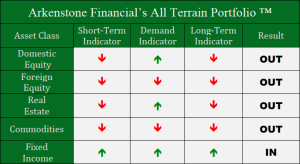Global and domestic stocks slid to start February, but a major announcement by OPEC gave markets a reason to rally. Stocks nearly recouped all of their losses from earlier in the month on hopes that oil has finally found a bottom.
Domestic Equity
U.S. equities got off to a very poor start in February due to the close connection between stock performance and oil. However, when oil got a boost from the OPEC announcement and rallied out to close the month, domestic stocks followed along. The announcement couldn’t have come at a better time, as stocks were quickly approaching a key support level and bounced off of it almost exactly as the oil announcement was made. Despite this seemingly good news, domestic stocks still finished February in the red. Even more concerning is the likelihood the Fed will leave rates as-is in March. A rate hike would be the second rate hike in a series of rate hikes as part of the Fed’s growth lift off plan, and if the Fed doesn’t raise rates as originally planned, this could be perceived as both leadership weakness and economic weakness – either of which could spook investors. Also concerning is Fed chairwoman Janet Yellen’s acknowledgment that negative interest rates were “not off the table,” in her semiannual congressional testimony.
The last day of February also confirmed a temporary “bearish cross” for the popular U.S. stock market index, the S&P 500. The bearish cross occurs when short term price momentum crosses down through longer term price momentum. This could end up being nothing in the end, but the only two other occurrences of this cross over the last 22 years occurred on the eve of cyclical bear markets, March 2001 and May 2008.
Foreign Equity
Global stocks can’t find any real footing and seem to be stuck in the same downward trajectory they’ve been in for over a year now. Low oil prices continue to hurt foreign economies and China is still unstable. China managed to stay out of February’s headlines for the most part, but the country’s government did push through a policy move that lowered bank reserves in effort to spur lending and promote economic growth. The sheer volume of monetary policy moves coming from China in the last year seems to indicate the country’s rising desperation. Global growth is weak and, with very few bright spots in the global economy, looks to remain so.
Real Estate
Real estate rallied to close the month along with U.S. stocks. Investors must be banking on interest rates staying low, which could spur both commercial and residential real estate growth. However, this asset class has been trading in a very tight window for a while, so this appears to be nothing more than a short-term cyclical price movement. Most likely this asset class doesn’t break out unless U.S. stocks do as well.
Commodities
Still no buy signal in commodities, but February was perhaps the most positive month for this asset class in years. OPEC announced that they will cut oil production to help with the massive oversupply in the industry. Prices have been falling because of this oversupply, but OPEC had previously maintained that they would not cut production in order to sustain global market share. Since the announcement, both oil and stocks have rebounded. Additionally, gold has been on a tear to start the year and it continued into February. The yellow precious metal is up roughly 16% year to date and investors are flocking to it as market uncertainty grows.
Fixed Income
Aside from high yield bonds, also known as junk bonds, fixed income had an excellent month. Like gold, this could be an indicator of market sentiment right now, as the “flight to quality” seems to be full swing. Investors typically sell stocks and buy bonds, particularly U.S. government bonds, in times of stock market uncertainty. The unprecedented factor this time around is that bond yields are particularly low and most expect the Fed to pass on a March interest rate hike. In fact, this past month Fed Chairwoman, Janet Yellen, indicated that negative interest rates were not out of the question and are part of the Federal Reserve Board’s consideration going forward. If bond yields were negative, we assume that changes the desirability of bonds, even in market uncertainty. This bears monitoring going forward, to say the least.
Chart as of 2/29/16
Past performance is not indicative of future results. Other asset classes or investment vehicles may be used in client portfolios and client portfolios may not hold all positions of the model at the same time as the model. This chart and its representations are only for use in correlation to the proprietary timing model by Arkenstone Financial, Registered Investment Advisor. Actual client and All Terrain Portfolio(TM) positions may differ from this representation.
- U.S. Stocks Make New Highs - December 6, 2024
- Rising Rates Create Headwinds - November 8, 2024
- The Fed Finally Cuts Rates - October 10, 2024




Leave a Reply